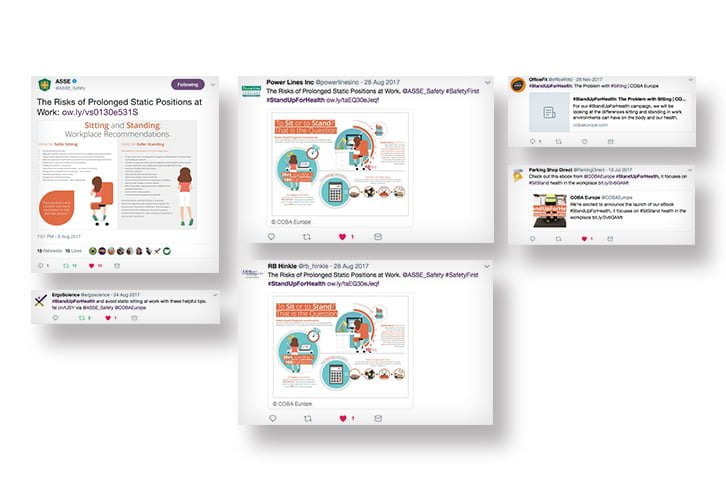
Our eBook #StandUpForHealth is one of the most popular downloads from our COBA website. From this, we can presume that more and more companies are recognising the importance of safe and comfortable standing (as well as sitting) in the workplace to reduce the risks to employees of both upper and lower limb musculoskeletal disorders (MSDs).
We are pleased to say that we are now in the process of releasing an updated e-Book which will feature the full results of our 2018 ‘Standing at Work’ Survey. Meanwhile, we would like to share a preview of some of the key findings from all the individuals who took the time to participate:
- 69% of respondents said they had colleagues who had experienced back, leg or foot pain as a result of standing at work. (Occupations included manufacturing, retail, construction, distribution, catering and hospitality.)
- Back pain accounted for 85% of health conditions as a result of standing at work, with 50% of respondents saying they (or colleagues) had suffered from Varicose Veins and 47% having sore feet as a result of their occupation.
- 45% of respondents identified people taking sick leave as direct result of standing at work. 65% considered sick leave to have an impact on productivity within their organisation.
- Of those who invested in anti-fatigue matting as a solution, 68% considered this to have had a positive effect on the wellbeing of staff. 86% found anti-fatigue matting helped to reduce pain or serious health conditions.
New work-related MSD statistics from the Health and Safety Executive
Addressing the ongoing impact of Workplace Fatigue and Musculoskeletal Disorders (MSDs)
Work-related musculoskeletal disorders (MSDs) remain a significant concern in UK workplaces. According to the Health and Safety Executive (HSE), MSDs consistently account for a substantial portion of all days lost to work-related ill health. These conditions not only cause personal suffering for the individuals affected but also result in considerable productivity losses for employers.
At COBA, we believe that awareness and prevention are critical. That’s why we continue to champion a proactive approach to employee wellbeing, encouraging organisations to embed preventative measures into their workplace culture. Regular risk assessments are essential, and one effective example is the implementation of a structured “Sitting and Standing Policy.” This might include scheduled breaks, job rotation to reduce prolonged static postures, and the creation of ergonomically optimised work environments to minimise strain.
Building on our commitment to workplace health, COBA recently partnered with OnePoll to survey 1,000 non-office workers who spend at least four hours a day standing. The study revealed striking findings: over 80% of respondents reported experiencing at least one health issue related to workplace fatigue. These insights underscore the urgent need for continued focus on fatigue-related risks. Through ongoing research and educational initiatives, COBA is dedicated to deepening the industry’s understanding of workplace fatigue—providing fresh data, expert-led insights, and practical solutions to help employers create safer, healthier working environments.
Anti-Fatigue Mats helping to prevent standing related fatigue
Additional ‘MSD-preventative’ measures include the use of anti-fatigue mats as anti-fatigue matting, through its cushioned surface, can be beneficial to those who regularly stand during their working day.
While we used to associate anti-fatigue mats more with factory workers standing at production lines, other professions such as retail, hospitality and even office workers using standing desks, can also benefit from the right anti-fatigue mat to make standing more comfortable – and kinder to limbs and joints.
To understand exactly how anti-fatigue mats can help, the article we published on The Science of Standing can be helpful ….
#StandUpForHealth was first published by COBA in 2016 and the information has proved to be a valuable resource for a wide variety of companies, from small to medium sized enterprises to large multi-national names. Preventing the occurrence of MSDs in the first place is much easier than cure.
The updated release of our free to download eBook containing all the latest ‘standing safety’ news and statistics, along with some expert opinions is now available for free download.
Successful Launch of the e-book
COBA launched the #StandUpForHealth e-book, which details the health issues that come with sitting or standing for long periods of times, especially within the workplace. This e-book has highlighted the growing interest of workplace fatigue as the demand for this e-book is phenomenal and has been downloaded in various countries all over the world.
The sit-stand debate has taken off in the past couple of years, with more and more people deciding to incorporate standing desks into their offices. It may not seem it, but we, as people, spend the majority of our days sitting down. #StandUpForHealth explains the effects prolonged sitting can have on the body, as well as the benefits standing at work can have, when done safely.
Increased download demand across Europe

Widespread Recognition for COBA’s #StandUpForHealth eBook
Our #StandUpForHealth eBook has gained notable traction across the workplace safety community and beyond. It has been featured on several respected platforms, helping to amplify awareness about the health risks associated with prolonged standing.
American Society of Safety Engineers
The American Society of Safety Engineers (ASSE) highlighted our campaign on their website, offering in-depth commentary on the dangers of maintaining static postures at work and the importance of addressing workplace fatigue.
Tachmarx – Smart Customer Service Platform
Tachmarx featured our eBook with a focus on the “Science of Standing” section. Their spotlight emphasised the potential health implications of standing for extended periods and reinforced the educational value of our content.
Kennedy Flooring
As one of our valued matting customers, Kennedy Flooring showcased our eBook on their site, outlining key highlights and providing readers with a preview of the practical guidance it contains.

Social Media Mentions
Excerpts and discussions around the eBook have been widely shared on Twitter, helping to spark broader conversations around workplace wellness. We’d like to extend a heartfelt thank you to everyone—individuals, companies, and partners—who have helped spread the word about #StandUpForHealth.







